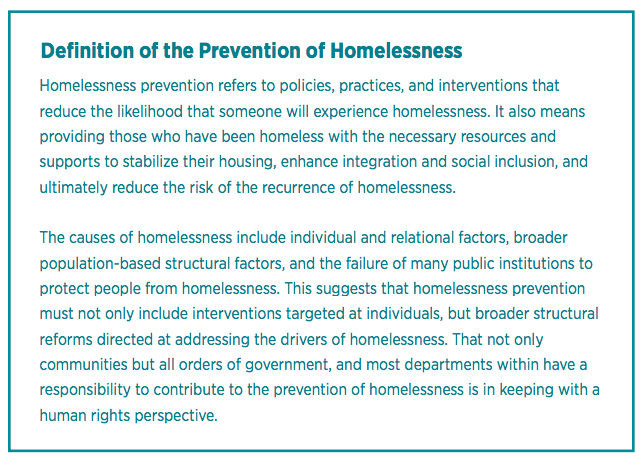“Most people intuitively understand that it is better to prevent a bad thing from happening – cancer, car accidents, etc. – than to deal with the consequences.”
For more than two decades, emergency services in the forms of soup kitchens and shelters, have been the dominant response to homelessness. While these services are important in helping meet people’s immediate needs, it does not have the effect of reducing and ending homelessness. In fact, these responses can trap people in homelessness and make it very difficult to become safely and securely housed.
In the last decade, Canadian policies and practices have begun to shift from managing homelessness to finding solutions. A New Direction: A Framework for Homelessness Prevention “provides a starting place for a national conversation about how to think about responding to homelessness in a different way; one in which we also seek to shut the front door.” The Framework maps out the evidence for preventing homelessness before it begins, or moving people out of homelessness quickly, by providing people with immediate access to housing. Ultimately, prevention efforts are key to bringing an end to homelessness.
What is Homelessness Prevention?
Homelessness prevention initiatives work to ensure people don’t experience homelessness. It is made up of policies and strategies that impact homelessness at the structural and systemic levels, as well as early intervention practices that address individual and situational factors.
The public health model of prevention, developed in the 1940s by Leavell and Clark, is a useful way to think about how prevention works. This model has been used in health care and health promotion to prevent cancer, diabetes, strokes, and smoking, to name a few. Later, it was adapted to prevent societal issues, such as crime and violence. Likewise, the Framework adapts the public health model to guide the implementation of homelessness prevention.
What Are We Trying to Prevent?
It is crucial that we understand the various, complex and interconnected causes of homelessness so that we can direct legislation, policy, and practices appropriately. The causes to homelessness can be broken down into three categories:
First, there are structural factors, such as economic and societal issues that affect opportunities, environments, and outcomes for individuals. This includes poverty, discrimination, lack of affordable housing, and the impact of colonialism on Indigenous Peoples.
Second, there are systems failures, where systems of support are inadequately delivered. Barriers to accessing public systems (health, social services, and legal supports), and failed transitions from publically funded institutions (child welfare, hospitals, and corrections) are examples of systems failures.
Third, there are individual and relational factors where personal circumstances, such as crises (like sudden unemployment or a house fire), mental health and addiction, housing insecurity, and interpersonal violence, can lead to homelessness.
Who’s Responsible?
For homelessness prevention to be successful, several sectors must take responsibility and work together. The homeless sector, such as non-profit organizations, are often seen as being solely responsible for homelessness. But in order to actually prevent homelessness, we need other systems to reach out to and support people before they are in crisis. Sectors like the health, justice, child protection, housing, and education systems, all have a major role to play in housing stability.
Homelessness prevention strategies include multiple systems and all forms of government, and collaboration between different departments and institutions to address the drivers of homelessness.
Prevention Works
Research on homelessness prevention demonstrates that prevention strategies succeed in reducing homelessness. For example, Pawson’s evaluation of prevention strategies in Scotland found that tenancy supports, such as landlord mediation, housing advice, and family mediation, greatly contributed to decreases in eviction. Furthermore, research shows the effectiveness of discharge planning and transitional supports from mental health hospitals, correctional facilities, and shelters as homelessness prevention strategies.
There is also research aimed at particular populations that detail essential preventative approaches, such as women experiencing intimate partner violence, and school-based early intervention strategies for Youth, such as Host Homes in the UK and the Reconnect Program and Geelong Project in Australia. The Geelong project is currently being adapted to the Canadian context in the Upstream Project.
It’s Worth It
Rather than continuously investing in short-term solutions, it makes more sense to assist individuals experiencing homelessness access adequate, affordable and safe housing. Homelessness costs the Canadian economy at least $7.01 billion annually. To put this in perspective, according to the Wellesley Institute’s Blueprint to End Homelessness, “the average monthly costs of housing people while they are homeless are $1,932 for a shelter bed, $4,333 for provincial jail, or $10,900 for a hospital bed. This can be compared with the average monthly cost to the City of Toronto for rent supplements ($701) or social housing ($199.92).”
Preventing homelessness is cost-effective. Research shows that preventive measures could reduce the public cost of addressing homelessness from $56,000 (CDN) per person annually, to $14,924. From this, overall savings in terms of government expenditures could be almost $600 million (CDN) if 40,000 people were prevented from becoming homeless for one year.
It’s a Human Right
Taken together, homelessness prevention doesn’t only make sense financially; an affordable, safe, and adequate home is also a human right. Many governments, including Canada, are signatories to international treaties and covenants that outline access to housing are human rights. For example, the International Covenant on Economic, Social and Cultural Rights (ICESCR) states that all signatory states must “recognize the right of everyone to an adequate standard of living for himself and his family, including adequate food, clothing, and housing, and to the continuous improvement of living conditions.”
Final Note
When we know that there are things we can do so that people avoid experiencing homelessness, how can we wait? Ending homelessness means working together to ensure that people are quickly, safely, and adequately housed and supported.


